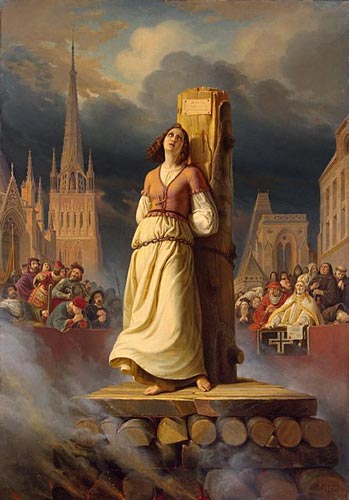 |
| Source |
Burning at the stake was a capital punishment method mostly used in the Middle Ages. This type of execution was usually preceded by a long torture(with different devices and instruments) and was a common way to punish blasphemers, thieves and witches, but it was also practiced for adultery and murder. Those who were in favor of burning at stake believed that it was a good way to scare and keep people from committing crimes.
There was, however, a law that required strangulating the person before burning them at stake, but there were many cases when victims were deliberately slowly burned alive. Approximately 200,000 people were burned at the stake for witchcraft because people believed that such an act would cleanse the soul of the condemned heretic; however, it was also a punishment since it meant that those condemned lost the body they would have taken into the afterlife.
A stake was erected for the victim on a spot designed for the following execution and around the stake piles of straw and wood were placed. The victim had their clothes removed and dressed in a shirt imbibed in sulphur; then the executioner would bound them to the stakes. After this, the fire was lit and the victim burned to death.
There were different ways of burning at the stake: the first method used a heap of faggots piled around a wooden stake (it seems that British and Spanish Inquisition had a special preference for this method because of its visual impact). Unfortunately for the victim, this was an extremely agonizing death because they were alive for a long time before the fire reached the head. The second method was more “humane” as it led to a quicker death since the victim died from carbon monoxide poisoning before suffering extreme pain. The third method involved a ladder with the victim tied on it, which was let down onto the fire.
 |
| Source |
Skillful Cruelty
There were different methods that were known to shorten the sufferings of the condemned person: the executioner placed a large iron bar that would have pushed against the victims and killed them faster or he placed gunpowder in the wood or at the victim’s neck to be sure of a quick death. However, the most fortunate were strangled to death before being burned.
Other executioners were ordered to prolong their victim’s suffering and they managed to do this by making the fire burn progressively(with green wood) from the calves to the face. There were records of victims that agonized over 2 hours before death. Some were simultaneously strangled and burned while others were only burned after being hanged for some time.
Here is a presentation of Catherine Hayes’ execution:
When they had finished their devotions (prayers), the carts were moved from under them leaving them suspended. Catherine was of course able to watch the men die and this must have been especially painful for her emotionally as Billings
Many people believe that burning at stake was only associated with witchcraft; however, it was associated with many other felonies and not all countries resorted to burning at stake for witchcraft. For example in England
Famous people burned at stake: Giordano Bruno, Thomas Cranmer, Joan of Arc, Girolamo Savonarola, and Patrick Hamilton.
Nowadays bride burning is a form of domestic violence practiced in India
The Progressive Women's Association declared that bride burning every year accounts for the violent death of at least 300 women, perpetrated most often by the victims' husbands or husbands' families," said the association's Shamoon Hashmi.
"bride burning is a form of domestic violence"
ReplyDeleteWell, i wouldn't call it domestic violence, more like,i don't know...murder?
:)) very true...but as a term(although a light term) domestic violence includes murder. Also, domestic violence in Islam is highly debated because most men declare that they are just following the Qur'an teachings.
ReplyDeleteHere's a sampleof arabian mentality and here's a sample of romanian mentality (part 1 ,part 2) regarding wife beatings. What are your thoughts on the issue? :D
ReplyDeleteWhat scares me the most about Qur'an is the fact that there is a methodology of beating :-s... There's not much sense comparing religions that have almost the same views upon women's role in society. At least Islamic people are hardcore believers while Romanians have no idea what they are celebrating. As for beating, I'm just a little bit shocked to see those women acting so natural about it. But I do believe that some women like the situation they are in (and I'm not referring to anything kinky ;))and they perceive the beating as a form of affection(he gets annoyed, therefore he cares).
ReplyDeleteWell i don't think a woman should associate affection with a beating. There are emotions behind a beating, yes, but not affection.
ReplyDeleteWould you please give the sources of your material? It would be nice to have this background material. Thanks in advance!
ReplyDelete